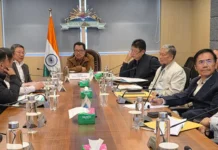Monday Musing
[ Junroi Mamai ]
Recently, the All Arunachal Pradesh Students’ Union (AAPSU) appealed to the Arunachal Pradesh government to conduct rigorous checking drives at the state’s various entry points and check gates as an immediate measure to prevent possible influx of illegal immigrants into the state following large-scale violence and the deepening political crisis in Bangladesh.
The state’s apex student body expressed concern that the potential entry of illegal immigrants into Arunachal could disrupt the tribal ecology and the demographic balance of the state.
The state government has also on its part acted promptly and issued strict ILP checking guidelines, which include mandatory police verification. Although these measures have been in place since decades, the influx of illegal immigrants into Arunachal has sadly remained unhindered.
The present situation in our neighbouring country Bangladesh and the neighbouring state of Manipur can only exacerbate the issue of illegal migration into Arunachal. Some districts of the state have witnessed sudden influx of refugees from violence-hit Manipur also. Though their numbers are less now, it may increase steadily, considering the continuing violence there. With porous international borders and interstate boundaries, Arunachal proves to be a safe haven for the violence-affected refuge seekers and illegal immigrants from neighbouring countries like Bangladesh and Myanmar, besides neighbouring states like Manipur.
It is a matter of grave concern, but unfortunately governments at both the state and the centre-level seem completely at a loss on this issue. What is concerning is the fact that the government of India till date does not have accurate data regarding the number of illegal immigrants in India.
We have witnessed how the settlement of Chakma and Hajong refugees in Arunachal in the past has led to the present-day political problems in our state. Present-day Arunachalis are still bearing the brunt of the past central government’s historic blunder. We all know how initially few in numbers, the refugee population slowly and gradually increased, using up the local resources for decades. These resources are limited, and with the increase in the population of the indigenous people, these resources would not be enough to sustain both the indigenous and the refugee population in the long run and would only result in possible conflict over them.
Similarly, the present-day influx of illegal immigrants from Bangladesh and conflict-ridden neighbouring states should definitely raise serious concerns among the people of Arunachal. Such unchecked influx, small or large, could pose a serious threat to the state’s demography and overburden the limited resources in future.
The people of Arunachal, in search of cheap labour for construction and farm work, often engage illegal immigrants. These efficient and cheap workers have slowly captured the labour, agriculture and related markets in the state with the help and support of the local indigenous people who let them till their land and sometimes lease it to them for a fixed monthly income. Moreover, their slow and gradual assimilation with the local indigenous people through matrimony and other social and economic interactions may also affect the cultural identity and disrupt the state’s demography in the near future.
The Centre and the state must come together and try to resolve the issue with strong political will, along with taking in the confidence of neighbouring states and countries involved, as well. Before it is too late, the government must act promptly to contain the influx of illegal immigrants and refugees in the state, and to preempt any possible clashes of the communities.



